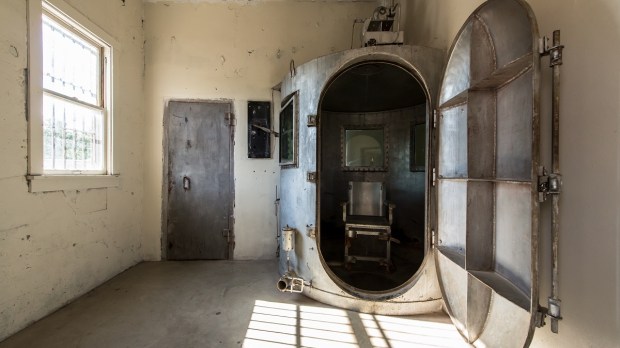In 1924, the US saw its first use of lethal gas in the execution of Gee Jon, a member of the Hip Sing Tong criminal society who was convicted of killing an elderly member of a rival gang in Nevada. The first attempt at executing Jon with gas was an utter failure that only served to show the state’s ignorance on the use of gas, as well as its tendency to experiment on prisoners. They tried to use the gas on Jon while he slept in his prison cell, in open air. The gas, however, only dissipated and had no effect.
It was a failure of foresight, as the executioners did not even seem to know how to use lethal gas. It was a failure of due process, as the condemned was not even aware that his execution was taking place. Furthermore, it was a failure of the state to protect the consciences of prison staff, for which four guards reportedly resigned so as to not take part in a lethal experiment on a human being.
This failed experiment led the state of Nevada to develop a gas chamber, but rather than building a new facility to ensure efficiency and safety, they rushed to convert the prison’s butcher shop into a makeshift chamber. After testing it on a cat, Gee Jon was strapped to a chair and four pounds of hydrocyanic acid were pumped into the chamber. Jon lost consciousness in a matter of seconds, but his head nodded up and down for several minutes, finally falling still 10 minutes after the gas was administered.
While Jon did die, and the execution could be considered a success in that regard, there were many failures in this attempt as well. An electric heater that would keep the temperature at 75 degrees, the proper temperature to allow the liquid to evaporate into gas, failed and left the room at a chilly 52 degrees. This caused a puddle on the floor that made the room unable to be entered until it dissipated. The observation room also had to be evacuated for fear that the gas was leaking from the chamber.
100 years later, almost to the day
Nearly 100 years to the day, the US has shown that it continues to employ experimental means of execution with lethal gas. On January 26, 2024, just two weeks shy of the 100-year-anniversary, convicted killer-for-hire Kenneth Eugene Smith became the first person in the US to be executed by nitrogen gas. While the execution was safer for those who bore witness, its description paints a ghastly picture that makes the 1924 cyanide gas execution pale in comparison.
In what could be construed as another failure, the Associated Press tells that Smith’s execution took approximately 22 minutes to complete – more than twice that of Gee Jon’s – and for at least two of those minutes, Smith convulsed in “seizure-like spasms.” The force of these jerking movements was enough to make the gurney he was strapped to visibly shake, followed by several minutes of heavy breathing before he finally went still.
While the Alabama Attorney General, Steve Marshall, has called the execution “textbook,” the arduous execution of Smith has raised alarm with anti death penalty groups and Death Row inmates who have already signed up for nitrogen executions, as it was pitched to them as a painless alternative to lethal injection. John Palombi, who represents some of these inmates who are reconsidering, said in a statement:
“The State promised the world the most humane method of execution known to man. Instead, Mr. Smith writhed and thrashed before he died. No further executions should take place by this method until the events of this evening are examined by an independent body.”
Palombi’s assessment was agreed upon by Smith’s spiritual adviser, the Rev. Jeff Hood, who was present at Smith’s execution. He brought attention to the failure of the gas to make Smith lose consciousness within seconds of the execution:
“We didn’t see somebody go unconscious in 30 seconds. What we saw was minutes of someone struggling for their life,” said Hood.
As for why the nitrogen gas execution went the way it did, Dr. Philip Nitschke, who developed the nitrogen gas chamber used in Smith’s execution, noted that the process requires some cooperation on the part of the condemned for it to work most efficiently. He said that Smith’s reaction was similar to someone who was only taking the slightest breaths of the gas, while trying to hold onto their lives. Dr. Nitschke suggested that this would most likely be the norm for executions by nitrogen gas.
“I think this outcome is inevitable if the nitrogen gas is to be used in execution where people do not want to die and will not cooperate,” Nitschke said.
It is unclear if the calls for an independent investigation into nitrogen gas’ efficacy for use in executions will be heeded. AG Steve Marshall’s final word on the matter was that the execution was successful and is “no longer an untested method,” but a “proven one.”
It is the view of the Catholic Church that all employment of capital punishment is “inadmissible because it is an attack on the inviolability and dignity of the person.”



